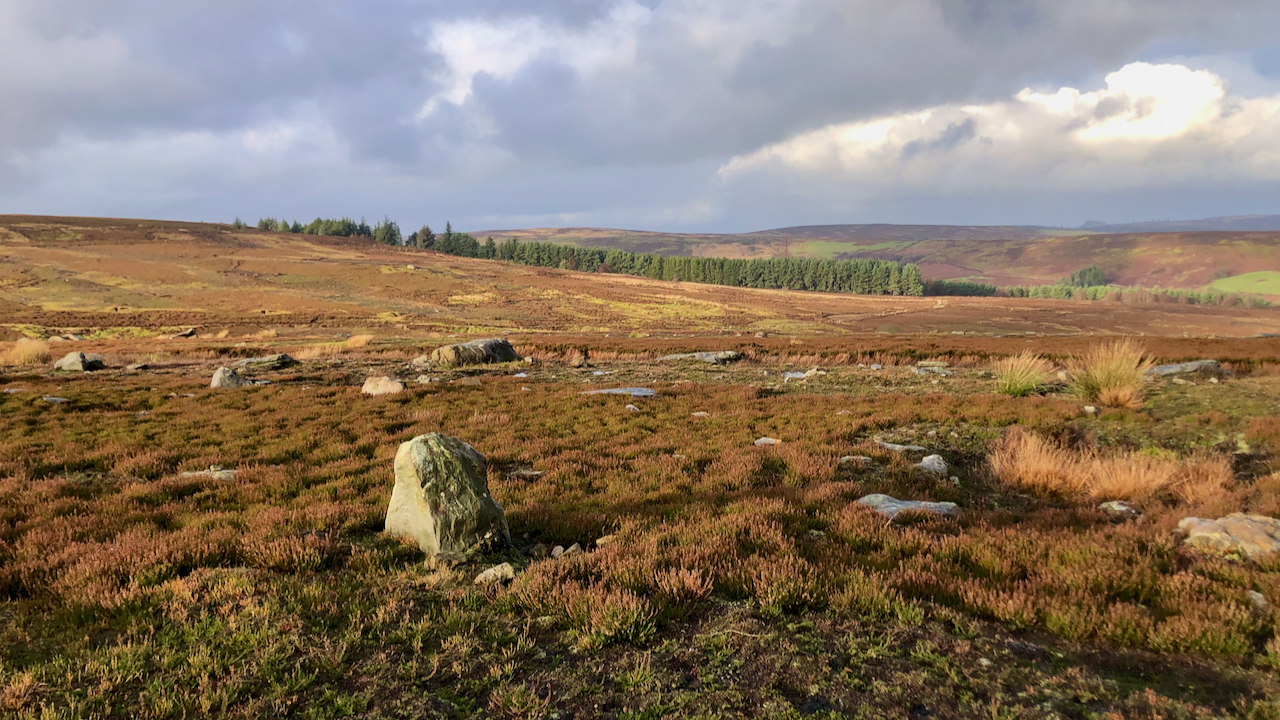Today was such a day. Rain, drizzle, a brief interlude of bright sunshine, then more drizzle, followed by a touch of rain.
I was on the bridleway mapped as Skinner Howe Cross Path crossing Great Hograh Moor when the sun made one of its brief appearances. This is looking north-west across Baysdale, look closely and you might make out Roseberry Topping popping its head above the skyline.
What comment to make?
I thought that as we’re now well in to the festive season, a comment on a culinary tradition would be in order — mince pies.
Spicy mince pies have been relished in England ever since the Crusaders brought spices back from the Middle East in the 12th century. As the name suggests they originally contained a lot of meat.
Someone had the bright idea that these spices, nutmeg, cloves and cinnamon, were symbolic of the gifts given to the baby Jesus by the three wise men in Bethlehem1Walkers Shortbread. 2016. ‘Walker’s Shortbread Ltd’, Walker’s <https://www.walkersshortbread.com/the-history-of-mince-pies/> [accessed 4 December 2022], and an association with Christmas began. Pie cases were made in an oval shape, and said to represent the crib in the manger, while the lid, the cloth he was swaddled in.
By the time of the Tudors and early Stuarts, Christmas had developed into a prolonged celebration lasting the full Twelve Days. Then along came the English Civil War and the beheading of Charles I.
Oliver Cromwell, deeply religious and puritanical, took over and effectively abolished Christmas.
They were of opinions that… Plumb-Pottage was mere Popery, that a Collar of Brawn was an abomination, that Roast Beef was Antichristian, that Mince Pies were Relics of the Whore of Babylon, and a Goose, a Turkey, or a Capon, were marks of the Beast.’
(From a 1652 pamphlet ‘The Faithful Scout‘)2‘A HISTORY OF ROYAL FOOD AND FEASTING’. 3.16. The early Georgian Christmas. Online Course. UNIVERSITY OF READING
When Christmas was re-established in 1660 it was never quite the same again.
Along with the increasing public taste for sugar, meat as an ingredient in mince pies declined and mince pies became sweeter.
Here is a recipe for ‘Mynce Pyes‘ from the reign of ‘good’ Queen Anne3BLAKEBOROUGH, R. ‘Doctors, Cooks, & Housewives of 100 Years Ago.’ | Northern Weekly Gazette | Saturday 10 January 1903 | British Newspaper Archive’. 2022. Britishnewspaperarchive.co.uk <https://www.britishnewspaperarchive.co.uk/viewer/bl/0003075/19030110/130/0012> [accessed 21 November 2022]:
Tyrste take you 13 egges hard boyled, through (throw) out half ye whites; 2lb. suet, 1lb. prunes (stoned), ½lb. raysons, a gill of sack4Sherry—any Spanish white wine, a quarter-pound lemon peall, half-ounce cinnimon and nuttmegge, adde sugar to taste, the like of mace and cloves, 4 apples shred small, and putt in a little verjuce for to sharpen, then putt into your pans lined with good puffe paste.
FOR THE MAYKINGE OF A GOOD PUFFE PASTE.
Yow will well rubb a quarter of a pound of fresh butter into a pound of fine flour, then whipp the whites of two egges to snow, and with cold water and one yolk make it into a paste, then roll it abroad, and putt in by degrees a pound of fresh butter, flouring it over the butter every time, and roll up, and roll it out again, and putt in more butter. So do for all or seven times, till the butter be all taken up. This paste is good for tarts or any smalle things. Note. —Lett not the maykinge of your puffe paste be given to a maid who hath sweathy hands or of an evil temper, for it be proven that both in an ill way do spoil the flake and lightness thereof.
If you’re tempted to share this recipe out and can find a Tesco in which eggs are not rationed, then please let me know.
- 1Walkers Shortbread. 2016. ‘Walker’s Shortbread Ltd’, Walker’s <https://www.walkersshortbread.com/the-history-of-mince-pies/> [accessed 4 December 2022]
- 2‘A HISTORY OF ROYAL FOOD AND FEASTING’. 3.16. The early Georgian Christmas. Online Course. UNIVERSITY OF READING
- 3BLAKEBOROUGH, R. ‘Doctors, Cooks, & Housewives of 100 Years Ago.’ | Northern Weekly Gazette | Saturday 10 January 1903 | British Newspaper Archive’. 2022. Britishnewspaperarchive.co.uk <https://www.britishnewspaperarchive.co.uk/viewer/bl/0003075/19030110/130/0012> [accessed 21 November 2022]
- 4Sherry—any Spanish white wine

Leave a Reply